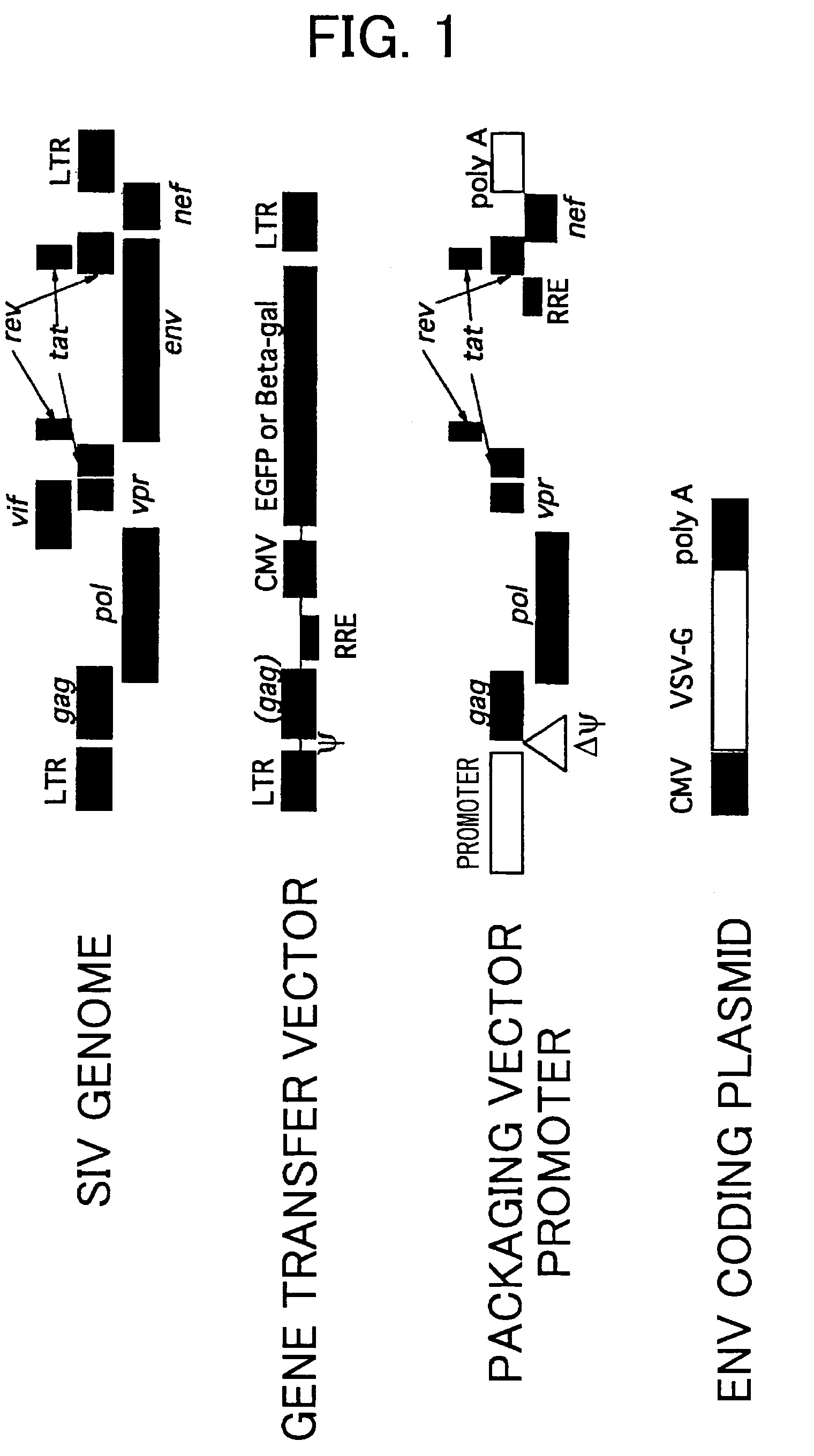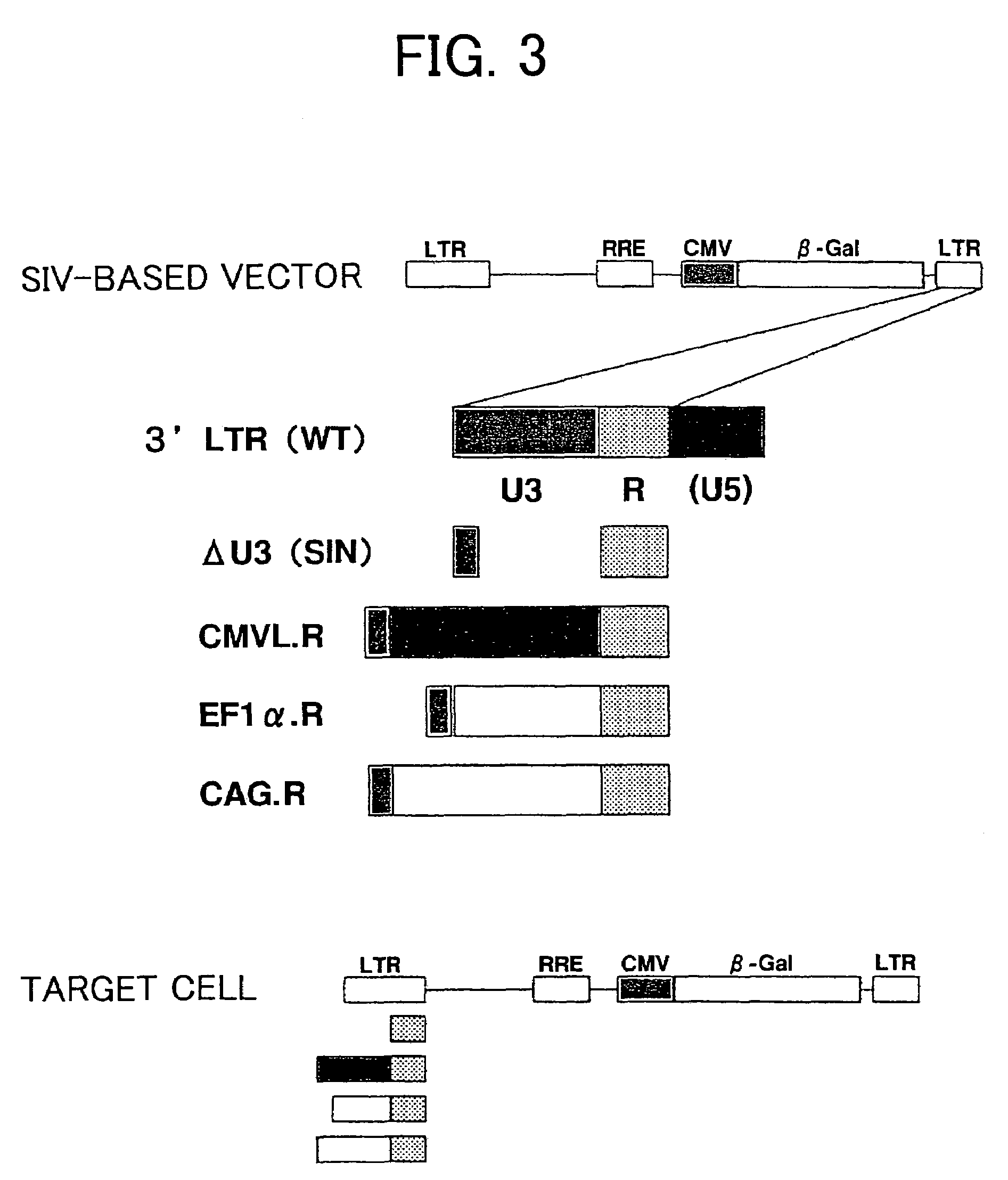Gene transfer into primate embryonic stem cells using VSV-G pseudotyped simian immunodeficiency virus vectors
- Summary
- Abstract
- Description
- Claims
- Application Information
AI Technical Summary
Benefits of technology
Problems solved by technology
Method used
Image
Examples
example 1
Generation of SIV Vectors
[0083]SIVagmTYO1 comprising a clone of an African green monkey-derived nonpathogenic immunodeficiency virus was used in the generation of a vector system. FIG. 1 shows the outline of the vector system. All nucleotide numbers are indicated below, with the transcription initiation site of the viral RNA as +1. pSA212 in which SIVagmTYO1 had been inserted was used as a plasmid (J. Viol., vol. 64, pp307-312, 1990). All ligation reactions were carried out using Ligation High (Toyobo) according to the attached instructions.
a. Generation of a Packaging Vector
[0084]First, a DNA fragment corresponding to the region (5337-5770) containing vif and the first exon of tat / rev was obtained by PCR, using pSA212 as a template, and using primers 1F (SEQ ID NO: 1) and 1R (SEQ ID NO: 2). A DNA fragment with an EcoRI site at its 3′ end was prepared by designing a PCR primer with an EcoRI restriction enzyme site. After digestion with BglII and EcoRI, the PCR fragments were purifie...
example 2
Modification of 5′LTR
[0087]The transcriptional activity of 5′LTR from lentivirus generally depends on the presence of Tat protein, which is a virus-derived factor. Thus, to eliminate Tat dependence as well as to enhance vector titer by replacement with a promoter sequence with stronger transcriptional activity, an SIVagm gene transfer vector was generated. In this SIVagm gene transfer vector, the U3 region, a promoter sequence of the 5′LTR, was replaced with another promoter sequence (FIG. 2).
[0088]The replacement of the 5′LTR with a chimeric promoter was achieved as follows. A fragment containing the region downstream of the TATA box on the 5′LTR through to the gag region (9039-9170+1-982) was amplified by PCR using pSA212 as a template and using a series of primers 9-1F to 3F (SEQ ID NOS: 21-23) and primer 9R (SEQ ID NO: 24). Further, fragments containing the CMVL promoter (derived from pCI (Promega); 1-721) were amplified by PCR using pCI as a template and a pair of primers 10-1F...
example 3
Modification of the 3′ LTR
[0089]A self-inactivating (SIN) vector was constructed by removing a portion from the 3′ LTR sequence such that transcription of full-length vector mRNA in target cells was prevented, and safety was improved. In lentivirus vectors it has been demonstrated that the U3 region, which serves as a promoter sequence in the 3′ LTR, can be integrated into the 5′ LTR U3 promoter region when reverse-transcribed in target cells. Therefore the 3′ LTR U3 region of the gene transfer vector plasmid can serve as the 5′ LTR U3 promoter involved in gene expression in the genome of target cells (FIG. 3). Thus, a vector was prepared in which the 3′ LTR U3 region of the SIVagm gene transfer vector was replaced with another promoter sequence (FIG. 3). In addition, in order to test whether the 5′ LTR promoter sequence can be deleted in target cells, a vector in which the 3′ LTR U3 region of the SIVagm gene transfer vector had been deleted was also prepared.
[0090]The modification ...
PUM
| Property | Measurement | Unit |
|---|---|---|
| Volume | aaaaa | aaaaa |
| Volume | aaaaa | aaaaa |
| Volume | aaaaa | aaaaa |
Abstract
Description
Claims
Application Information
 Login to View More
Login to View More - R&D
- Intellectual Property
- Life Sciences
- Materials
- Tech Scout
- Unparalleled Data Quality
- Higher Quality Content
- 60% Fewer Hallucinations
Browse by: Latest US Patents, China's latest patents, Technical Efficacy Thesaurus, Application Domain, Technology Topic, Popular Technical Reports.
© 2025 PatSnap. All rights reserved.Legal|Privacy policy|Modern Slavery Act Transparency Statement|Sitemap|About US| Contact US: help@patsnap.com



